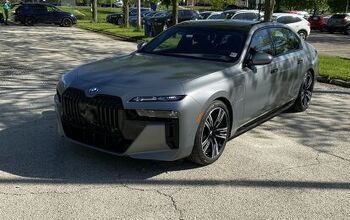Auto Industry Group Pushes Back Against the NHTSA's Updated AEB Rules

Earlier this year, the National Highway Traffic Highway Safety Administration updated its rules on automatic emergency braking, opting to require that almost all new cars and trucks carry the feature by 2029. Now, a group representing most major automakers is pushing back, saying that the requirements are “practically impossible with available technology.”
The NHTSA’s updated rule requires cars and trucks to stop at speeds up to 62 mph, significantly faster than most offer today. The Alliance for Automotive Innovation, which represents GM, Toyota, and most others, noted that the higher speeds would require much earlier braking times from AEB systems, which could result in surprised drivers and rear-end collisions.
The Alliance’s CEO, John Bozzella, said the change “won’t improve driver or pedestrian safety.”
He also noted that the new rule “points to the breakdown of a deliberative rulemaking process at the country’s top traffic safety watchdog.” The NHTSA believes the change could save at least 360 lives and prevent 24,000 injuries annually.
In addition to stopping cars at up to 62 mph, the NHTSA’s ruling requires that AEB systems apply the brakes automatically at up to 90 mph “when a collision with a lead vehicle is imminent, and up to 45 mph when a pedestrian is detected.”
Many new vehicles come with AEB technology, but in addition to surprising drivers with earlier braking times, such a significant change in how the systems operate could result in higher costs for buyers as automakers look to recoup development costs. That said, it’s hard to argue against saving lives and preventing injuries.
[Images: Ford, Toyota, VW]
Become a TTAC insider. Get the latest news, features, TTAC takes, and everything else that gets to the truth about cars first by subscribing to our newsletter.

Chris grew up in, under, and around cars, but took the long way around to becoming an automotive writer. After a career in technology consulting and a trip through business school, Chris began writing about the automotive industry as a way to reconnect with his passion and get behind the wheel of a new car every week. He focuses on taking complex industry stories and making them digestible by any reader. Just don’t expect him to stay away from high-mileage Porsches.
More by Chris Teague
Latest Car Reviews
Read moreLatest Product Reviews
Read moreRecent Comments
- ToolGuy Doesn't matter, EVs don't work, even if they do I mean did they won't I mean wouldn't have the range to drive to the track. Plus the world is running out of electricity (and there is no way to make more). The panel gaps on EVs are aerodynamically problematic, especially Porsche. No one can afford EVs. There is no place (literally -no- place) to charge, and even if you do I mean could it will I mean would crash the U.S. electrical grid and there is no way to restart it, ever. Drivers will grow old and die waiting for the vehicle to charge. EV racing will never benefit the environment the way that ICE racing does and has and will. The batteries cost more than the vehicle and that cost goes up every minute. All electricity is dirty and nasty and not wholesome like petroleum. EVs are slow (as in the opposite of quick) and the point of a drag race is quick. I can't hear well because of ICE and what happens when a silent EV runs over me at the track? It is a good thing that the EV thing ended when it did and will never return. I for one am relieved.
- MaintenanceCosts It at least looks more like a Cadillac and less like a Traverse than the XT6. I'm a shopper in this segment and would give it a test drive, which I wouldn't bother with for the XT6.
- 1995 SC Early El Camino = coolLate El Camino = coolThis one = not cool
- AZFelix A calendar search shows Saturday May 14th could have recently been in 2005, 2011, 2016, and 2022. The phone number now shows for Coys Wheel in Kaysville, UT.
- ToolGuy Tim said climate change is real, so I don't think this will ever apply to me.





































Comments
Join the conversation
As of now I would side with the opposition camp. The technology is not mature enough or cheap enough. And even when it is it will only be effective for a few years until peoples Tires are no longer able to deliver optimal stopping power and control. At this point people's diminishing buying power woukd be better spent on more aggressive Brake nd Tire maintenence (and selection) than than another pricey tech gizmo that will cost thousands of dollars down the road for module replacement and bogus "reprograming" fees as it is with VDC, BCM's, TCM's Electric Steering ect.
The first regulatory effort whould be to set minimum performance standards for approved Tires qnd aftermarket Brakes. And if higher operating costs are to be imposed on drivers it should first be on stopping and traction related maintenence. When I survey the cars jn my workplace and residential parking areas, I get chills from the age and condition of the tires on which at least 20% of people drive.
I expect the Industry's opposition will soften if they get assurances that they will have no responsibility for covering this system beyond the basic warranty period so there is no chwnce of it becoming a more expensive version of the AirBag debacle.
On the other hand I would be more supportive if the Feds force them to cover such mandatory safery features for the life of the car (with some tax credits for.doing so). REAL sustainability is being abke to affordably drive the car at least 25 years.